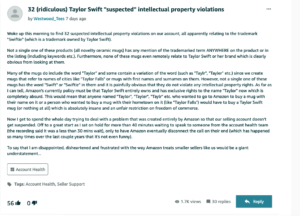
Enhancing Trust and Safety: Analyzing Amazon’s Brand Protection Efforts and Pathways for Improvement
- Amazon has demonstrated a strong commitment to brand protection through a comprehensive approach that includes a $1.2 billion investment and a team of over 15,000 dedicated professionals. The company’s efforts in 2023 led to the seizure and disposal of over 7 million counterfeit products, showcasing a robust mechanism to safeguard the marketplace. Amazon’s proactive measures have been highly effective, with more than 99% of suspected infringing listings blocked before brands need to take action. Innovations in seller vetting have significantly reduced bad actor attempts to create new selling accounts, further securing the platform.
- In addition to these protective measures, Amazon has engaged in educational initiatives aimed at raising awareness about the dangers of counterfeit goods. Collaborations with industry experts and associations, such as the Unreal Campaign Challenge with the International Trademark Association (INTA) and DECA, have reached a wide audience, underlining Amazon’s commitment to not just enforcement but also prevention through education.
- While Amazon’s efforts are commendable, there are areas where improvements could amplify their effectiveness. Streamlining access to brand protection tools could make it easier for brands to protect their intellectual property. Increased transparency in the form of detailed reporting could provide brands with better insights into the protection mechanisms at work. Tailoring brand protection strategies to the unique needs of different industries, ensuring equitable access to resources for smaller brands, and intensifying efforts to tackle global counterfeit networks could further enhance the efficacy of Amazon’s brand protection efforts.
- In summary, Amazon’s multifaceted approach to brand protection showcases its dedication to creating a secure and trustworthy marketplace. By focusing on areas for improvement, Amazon can continue to evolve its strategies, ensuring that it remains a safe platform for brands and consumers alike.
Caught in the Crossfire: A Small Seller’s Struggle with ‘Swiftie’ Trademark Claims on Amazon”
- This morning, a small seller awoke to the alarming discovery of 32 suspected intellectual property violations on their Amazon account, all linked to the trademark “Swiftie,” owned by Taylor Swift. Despite the products in question—novelty ceramic mugs—bearing no reference to the trademarked term or any association with Taylor Swift or her brand, they were flagged. The seller clarifies that some mugs feature the name “Taylor” or variations thereof, related to city names or personal names, not “Swift” or “Swiftie.” This situation underscores a perplexing issue with Amazon’s automated enforcement system, suggesting it might overextend Taylor Swift’s trademark rights to any use of “Taylor,” an action that restricts commerce unfairly. The seller now faces the daunting task of resolving this issue to avoid account suspension, compounded by challenges in accessing support from Amazon’s account health team.
- The recent case of unjust “Swiftie” trademark claims on Amazon highlights a critical need for refined safety checks in digital marketplaces. This issue, where legitimate products were mistakenly flagged, showcases the undue challenges faced by good sellers, diverting their focus from business growth to resolving unwarranted disputes.
- This incident serves as a vital lesson for all sellers on the importance of advocacy and vigilance in protecting their interests. It also calls on platforms like Amazon to enhance their systems, ensuring that legitimate sellers are not unfairly penalized.

Millennial Amazon Shopping Behaviors Report Summary
- The recent “Millennial Amazon Shopping Behaviors” report unveils crucial insights into how Millennials interact with Amazon, highlighting their status as significant spenders with an average annual expenditure of $69,061. Key discoveries point to Amazon and Google as primary discovery channels, a strong millennial presence on social media, and a notable openness to purchasing through Amazon ads.
- Key Takeaways:
- 74% of Millennials use Amazon for product discovery, surpassing social media platforms.
- 8 million Millennials are active on social media, emphasizing the importance of targeted social media marketing.
- 20% increase in TikTok usage among Millennials from 2021 to 2023, signaling the platform’s growing influence.
- 68% rely on online retailers and search engines for product research, underscoring the value of SEO and platform optimization.
- 74% are influenced by Amazon ads to make purchases, highlighting the effectiveness of Amazon’s advertising solutions.
The Stand Mixer Saga: A Case Study in Amazon Listing Hijacks
- A recent incident involving an Amazon product listing for a stand mixer, which was maliciously altered to include vulgar language, has brought to light a longstanding issue faced by third-party sellers on Amazon. This scenario, shared widely across eCommerce circles on LinkedIn, underscores the ease with which product listings can be hijacked, a problem that has plagued the platform for over a decade.
- Key Points:
- The offensive listing remained on Amazon for over 12 hours before being taken down, revealing gaps in Amazon’s monitoring and response systems.
- The incident reflects a broader issue where merchants with enough clout on Amazon can make unauthorized changes to others’ product listings, often through the Vendor Central portal intended for first-party brands.
- Such vulnerabilities have given rise to a black market of listings hackers, who sabotage competitors’ listings for ransom, exploiting weaknesses in Amazon’s Vendor Central.
- Efforts to rectify such issues are hampered by Amazon’s slow and often opaque process for approving changes, even for brands enrolled in Amazon’s Brand Registry.
- The problem is exacerbated by recent platform changes that further empower first-party vendors at the expense of third-party sellers, indicating a lack of meaningful action from Amazon to address these concerns.
- This serves as a critical reminder for brands to remain vigilant and underscores the need for Amazon to implement stronger safeguards to protect sellers from such malicious activities.
Keep up with the latest Amazon and Walmart news updates and subscribe to our BellaVix newsletter 👇👇👇
